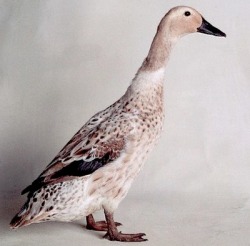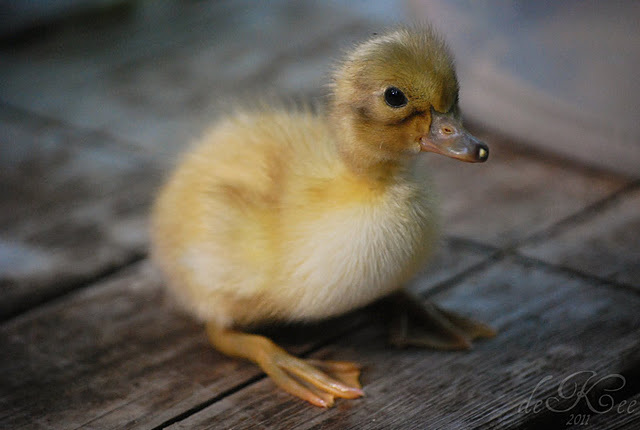All About Welsh Harlequin Ducks

True to their cultural heritage, the Welsh are a hardy and practical people. So it's not at all surprising that the Welsh created a breed of duck that is hardy and practical also!
In keeping with a down to earth, small and economical homesteading model, it makes good sense to raise dual purpose breeds rather than several to serve different and distinct purposes. These ducks are amazing layers, producers of flavorful lean meat, good mothers, ardent foragers, and have a calm and friendly demeanor. As anyone who knows me will tell you, I'm a sucker for practicality.
The Welsh Harlequin is not an old breed... it was developed in Wales in 1949 by Leslie Bonnet from two mutant light colored ducklings hatched from pure Khaki Campbell's. The breed was first imported into the U.S. in 1968, but remains relatively unknown here and the American Poultry Association didn't officially recognize it until 2001.

Gold Phase Hen (bronze wing speculum)
They are considered endangered in the U.S with only about 188 breeding Harlequins recorded. There is a critical need for more conservation breeders. Their excellent laying ability, lean meat, and stunning plumage make them a great addition to any small farmstead or backyard producer's flock. They have a wonderful temperament; Harlequins are docile, inquisitive, happy birds and noticeably calmer than Campbell's. Another feature homesteaders will find invaluable is that the Harlequin females will incubate their own eggs and they make good mothers.
Color Genetics
The Welsh Harlequin is a lightweight breed at 5-6 pounds, are streamlined, with relatively long bodies and wide-spaced legs. Welsh Harlequins are either gold phase or silver phase. The difference in golden and silver phase Harlequins is subtle in drakes. Mature gold phase males of have greenish black heads with an iridescent green sheen. A white neck ring fully encircles the lower neck. The breast, sides, shoulders and flanks are a creamy white with a chestnut or burgundy color giving a frosted or laced effect (a harlequin effect). The upper back displays a tortoise shell pattern with white, cream, topped in shades of brown and chestnut. These colors blend to silver grey at mid back, and brown at the tail, which has white edging. The wing primaries are a brownish grey edged in white, while the forewing is a mix of white and chestnut. The wing speculum is green or greenish bronze. The bill is greenish yellow with a black bean at the tip. Feet are orange with a brownish cast. Males of the silver phase have heads that show an even more intense green sheen. Their wing speculum is blue, and they display more grey on their back and wings.
Color Genetics
The Welsh Harlequin is a lightweight breed at 5-6 pounds, are streamlined, with relatively long bodies and wide-spaced legs. Welsh Harlequins are either gold phase or silver phase. The difference in golden and silver phase Harlequins is subtle in drakes. Mature gold phase males of have greenish black heads with an iridescent green sheen. A white neck ring fully encircles the lower neck. The breast, sides, shoulders and flanks are a creamy white with a chestnut or burgundy color giving a frosted or laced effect (a harlequin effect). The upper back displays a tortoise shell pattern with white, cream, topped in shades of brown and chestnut. These colors blend to silver grey at mid back, and brown at the tail, which has white edging. The wing primaries are a brownish grey edged in white, while the forewing is a mix of white and chestnut. The wing speculum is green or greenish bronze. The bill is greenish yellow with a black bean at the tip. Feet are orange with a brownish cast. Males of the silver phase have heads that show an even more intense green sheen. Their wing speculum is blue, and they display more grey on their back and wings.
The coloring of the female Welsh Harlequin varies greatly. The color diversity varies not just from flock to flock but also from duck to duck. Part of the reason for this is that gold phase ducklings and silver phase ducklings are often found in the same hatch. The adult female has a base color of cream feathers that are covered in a daubed pattern of brown, grey, rust, light orange, dark orange and buff. She also has the tortoise shell pattern of the male on the back, but lack the male's burgundy color on the breast, hers is a cream color, as is the underside.
|
The wing speculum is green or greenish bronze. The feet are orange in a young female, but becomes dark brown in older hens. Something to keep in mind when selecting for breeding is that hens don't get their full color and pattern until they are two years old.
Silver phased ducks differ from the gold in that the silver ducks have more grey tones and their wing speculum is blue. |
Ducklings are dunn colored with a slight blushing of black (silver phase) or brown (gold phase) on their heads. Welsh Harlequins can be sexed right after hatching with about a 90% accuracy. Take a look at their bill color within the first 3 days and note that a your girls will have pink bills and boys will be darker. Silver phase will have a dark silver coloring on the head and Gold phase is a pretty golden-brown.
.

Gold phase drake (note the green head)
Harlequins are primarily raised for their wonderful laying ability. Coming from Campbell stock, they are equally as highly adaptable and energetic. Unlike Campbells, the mature Welsh Harlequins are much calmer, a lot quieter, and much easier to work with. Beginning at about 5-7 months old they are outstanding year-round layers, producing 260-330 pearly white-shelled, wonderfully flavored eggs yearly each weighing about 2.8 ounces, which would grade it as "extra-large" (this is can be compared to the Leghorn chicken, a high producing non-hybrid breed, which average 280 - 300 per year). They are also active foragers, excellent producers of lean meat, beautifully colored and pluck almost as cleanly as white birds when dressed for meat. Welsh Harlequin ducks can also make an outstanding dressed duck as their underfeathers are almost exclusively white making their carcass as pretty as a pure white Pekin.







